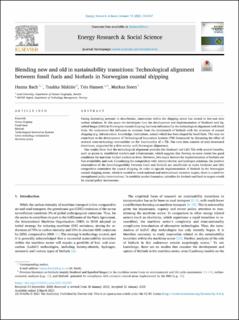| dc.contributor.author | Bach, Hanna | |
| dc.contributor.author | Mäkitie, Tuukka Rainer Reinhold | |
| dc.contributor.author | Hansen, Teis | |
| dc.contributor.author | Steen, Markus | |
| dc.date.accessioned | 2022-05-24T12:36:15Z | |
| dc.date.available | 2022-05-24T12:36:15Z | |
| dc.date.created | 2021-03-02T18:55:24Z | |
| dc.date.issued | 2021 | |
| dc.identifier.citation | Energy Research & Social Science. 2021, 74, 101957. | en_US |
| dc.identifier.issn | 2214-6296 | |
| dc.identifier.uri | https://hdl.handle.net/11250/2995964 | |
| dc.description.abstract | Facing increasing pressure to decarbonize, innovation within the shipping sector has turned to low-and zero carbon solutions. In this paper we investigate how the development and implementation of biodiesel and liquefied biogas (LBG) in Norwegian coastal shipping has been influenced by the technological alignment with fossil fuels. We understand this influence to emanate from the (mis)match of biofuels with the structure of coastal shipping (e.g. infrastructure, knowledge, institutions, actors) which has been shaped by fossil fuels. This way we contribute to the development of Technological Innovation Systems (TIS) framework by discussing the effect of sectoral cross-technology externalities on the functionality of a TIS. Our core data consists of semi-structured interviews, supported by a firm survey with Norwegian shipowners. Our results show that the technological alignment provides the biodiesel and LBG TISs with several benefits, such as access to established markets and infrastructure, which suggests that Norway to some extent has good conditions for maritime biofuel markets to form. However, two major barriers for implementation of biofuels are fuel availability and cost. Considering the competition with battery-electric and hydrogen solutions, the positive externalities of the interchangeability between fossil and biofuels are insufficient to make biodiesel and LBG competitive contenders for coastal shipping. In order to upscale implementation of biofuels in the Norwegian coastal shipping sector, which is needed to reach national and international emission targets, there is a need for strengthened policy interventions. To establish market formation, subsidies for biofuels and feed-in targets would be crucial policy instruments. | en_US |
| dc.language.iso | eng | en_US |
| dc.publisher | Elsevier | en_US |
| dc.rights | Navngivelse 4.0 Internasjonal | * |
| dc.rights.uri | http://creativecommons.org/licenses/by/4.0/deed.no | * |
| dc.subject | Green shipping | en_US |
| dc.subject | Fossil fuels | en_US |
| dc.subject | Biofuels | en_US |
| dc.subject | Technological Innovation Systems | en_US |
| dc.subject | Cross-technology externalities | en_US |
| dc.subject | Maritime policy | en_US |
| dc.title | Blending new and old in sustainability transitions: Technological alignment between fossil fuels and biofuels in Norwegian coastal shipping | en_US |
| dc.type | Peer reviewed | en_US |
| dc.type | Journal article | en_US |
| dc.description.version | publishedVersion | en_US |
| dc.rights.holder | © 2021 The Author(s) | en_US |
| dc.source.pagenumber | 12 | en_US |
| dc.source.volume | 74 | en_US |
| dc.source.journal | Energy Research & Social Science | en_US |
| dc.identifier.doi | 10.1016/j.erss.2021.101957 | |
| dc.identifier.cristin | 1895030 | |
| dc.relation.project | Norges forskningsråd: 268166 | en_US |
| dc.relation.project | Norges forskningsråd: 296205 | en_US |
| dc.source.articlenumber | 101957 | en_US |
| cristin.ispublished | true | |
| cristin.fulltext | original | |
| cristin.qualitycode | 1 | |

